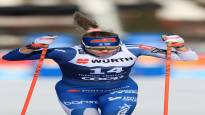According to Aino-Kaisa Saarinen, the financial problems of the Ski Federation are now directly reflected in the results of the sprint competitions. In previous years, sprint skiing was practiced a lot in the group.
As expected, Davos’ fast-paced sprint track and freestyle skiing severely cut off the Finnish participants in the time trial of the Tour de Ski on Wednesday. The women continued Jasmi Joensuu and Krista Pärmäkoskiof men Lauri Vuorinen and after Wednesday the tour stop Joni Mäki.
Kerttu Niskanen missed the next place by a mere 0.01 seconds.
– The 20-kilometer pursuit on a traditional Thursday is such a rough ride that Kertu still has a chance for a really tough overall ranking. Jessica Diggins is, in my opinion, quite an unattainable runaway, Urheilu’s expert Aino-Kaisa Saarinen states.
– Remi Lindholm and Arsi Ruuskanen (14.89 and 18.06 seconds from the top) will definitely ski at their best, but it’s a big problem if they can’t go any harder than that. If you think about, for example, mass starts of 50 kilometers in value races with free time, i.e. a distance very characteristic of Remi, then they are decided in the last hundreds of meters. There must be the kind of overspeeding ability that that Davos sprint track really invites. Otherwise, it won’t work.
The ways of freestyle skiing in the history of value competitions Hans Christer Holund ran away early in the World Championships 2019, otherwise it has gone to the end.
Denies Jauhojärvi’s claim
Jasmi Joensuu pointed out the lack, even non-existence, of the national team’s sprint training culture in connection with the Tour’s previous sprint in Toblach. An expert at Viaplay’s newsroom Sami Jauhojärvi stated that the history of women’s joint training as far as the sprint is concerned is thin throughout. Saarinen disagrees.
– I don’t know why “Musti” said that. At the time, there was a lot of joint training at the camps, specifically for sprints, says Saarinen, who has skied 11 times in World Cup sprints.
He talks about a special classic training, i.e. the head coach of Magnar Dalen from the planned “triangle exercise” on roller skis.
– There was a flat section, a downhill section and an uphill section. Certain clips were always pulled in full, and always as a group. There was no compromise on that. Especially when I was also involved Slender sprig (Fibrousnow Sarasvuo), Pirjo (Mannynow Muranen) and Riitta-Liisa (Roponen), so the challenge was always really tough and developing with both techniques.
Tight Magnar Dalen
At that time, from the middle of the 21st century onwards, the Ski Association’s camping program was also not such that everyone could have picked the most suitable pieces for themselves.
– Magnar demanded complete commitment to the entire camp program and within the camps to the training program of the camps. If it didn’t work out, it was agreed to train elsewhere. I would like something like this for the national team’s working methods.
Even in the joint exercises of long-distance trips, a certain selflessness was assumed from everyone.
– One skier hung on the tail of the Yhteislenk group without doing any pull-ups and passed at the end. It aroused a lot of irritation in the others, and it resulted in a conversation with the head coach.
According to Saarinen, the Ski Federation’s financial problems with reduced camps are directly visible, especially in the sprint results.
– Training together is very essential in sprinting.
Iivo Niskanen trained the entire training season on his own. Kerttu Niskanen did not go to the camps, even though he was nominally part of the strength of the national team.
– Regarding this training season, it is of course difficult to blame the athletes, when there really weren’t even any camps to refuse.
